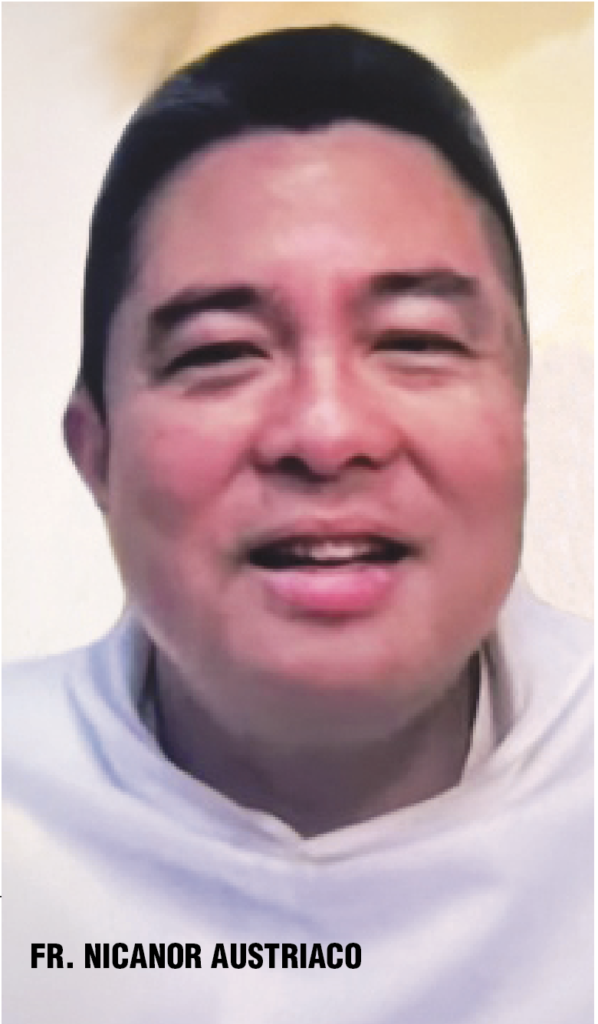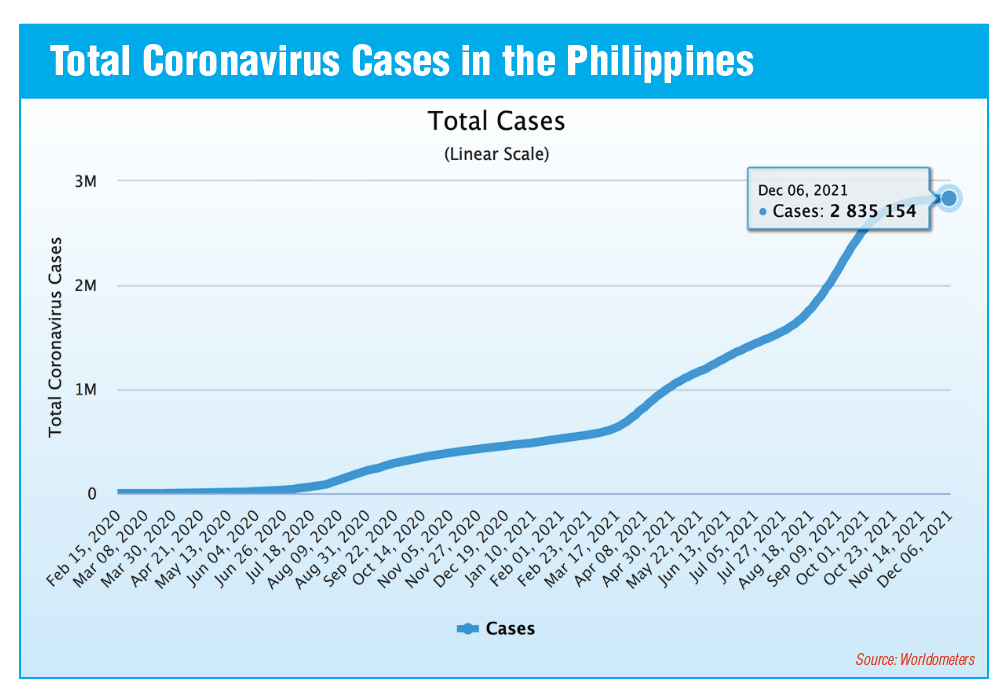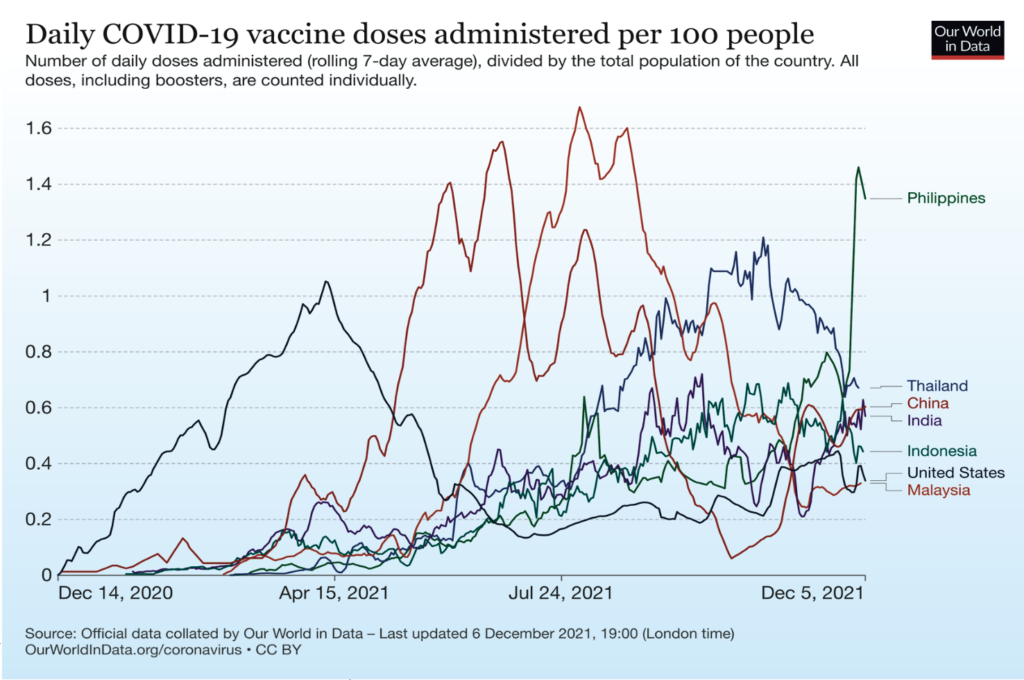
“The virus is struggling to find new Filipinos to infect,” says a US-based Filipino scientist, a micro biologist who is also a priest.
“With the vaccinations and the natural immunity, we are now stable enough to prevent transmission.”
Finally, we begin to see the light at the end of the tunnel. The Philippines appears to have survived and beaten the worst pandemic of the last 100 years.
COVID-19 appears to have run out of Filipino victims to infect, to immobilize, and or to kill.
“The virus is struggling to find new Filipinos to infect,” observed Fr. Nicanor Austriaco, a Filipino priest-scientist based in and teaching in the United States.
Credit the millions of Filipinos who got sick with COVID-19 and yet were unreported by the government. And credit the millions of Filipinos who were given jabs by the government. Combining the two—immunity from COVID for having been sick with it and immunity from COVID for having been inoculated with anti-COVID vaccines, you get what you call herd immunity. Officially, 2.8 million Filipinos got sick with COVID.
The first immunity is natural, the work of nature which creates antibodies in your body to protect you from future infections because your body now recognizes the COVID virus as an enemy and therefore has created robust defenders like the T-cells of your immune system.
The second immunity is man-made, thru vaccines, which are mostly overpriced and denied to many of the very poor who have no vaccine access.
A Dominican and MIT-trained scientist, Father Austriaco, has an MBA, a Ph.D. and a doctorate in theology. He is like an undisputed expert on three things –money, science, and theology. It is in his capacity as a molecular biologist that the cabinet listened to him intently on Monday night (Dec. 6, 2021). The good father claimed Filipinos have reached herd immunity.
In effect, the administration of President Duterte appears to have beaten the pandemic—so far. This augurs well for a happier Christmas season this December and January 2022 for most Filipinos.
The Philippines has the world’s longest Christmas season, from Simbang Gabi early morning of Dec. 16, until Three Kings Day, on Jan. 6, 2022.
The government having licked the pandemic, the tandem of former Senator Ferdinand “Bongbong” Marcos Jr. and Davao City Mayor Sara Duterte-Carpio can probably reap some benefits from the good news.
The pandemic mismanagement has been one of the issues against the Duterte administration, along with rampant corruption, extra-judicial killings, and the worst economic recession in history (triggered by Duterte’s longest and severest pandemic lockdown) which in turn triggered massive joblessness with 30 million Filipinos out of work.
Job offer
So impressed was President Duterte with the balik-scientist Austriaco’s Monday night presentation he offered the priest a job as secretary of health, to succeed the beleaguered Francisco Duque. Austriaco and Duque are both Thomasians, UST graduates. Smiling, Duque graciously agreed, to yield his job, “to another Thomasian.”
Happily for Duque, Austriaco declined. Duterte insisted, “we will be blessed, if you accept the portfolio of secretary of Health, short stint.”
Before Father Austriaco could be convinced, Senator Bong Go asked the Dominican scientist to pray for the government and the people instead.
Major conclusions
Here are Father Austriaco’s major conclusions with his perception of the pandemic:
• We are experiencing the lowest case numbers in 20 months, with an average of about 500 cases per day. Compare that with peak 26,208 cases on Sept. 11, 2021. The last time the Philippines had below 500 cases was on March 20, 2020, 497, nine days into the pandemic and five days after President Duterte enforced a massive lockdown that still has to be lifted.
In contrast with the Philippine daily average of 500 cases, the US, on Sunday (Dec. 5, 2021), had 120,000 new cases, related Austriaco. US has three times the Philippine population of 110 million, implying that the Philippines should be having 40,000 cases a day by now, not 500.
Lowest hospitalization in 20 months
• We are also experiencing the lowest hospitalization numbers in 20 months. Earlier Monday, Makati Med announced for the first time during the pandemic, they have no COVID-19 patients in their hospital. And this is typical of many hospitals throughout our beloved country.
• Yet, we are experiencing the highest mobility in 20 months. Most — many of our people are moving around now, the most in 20 months since the beginning of the pandemic and the lockdown in March of 2020.
• As a biologist, this is the question: We are currently with Delta, the most infectious variant in the past 20 months, the highest mobility levels in the past 20 months, more and more of our kababayans are moving around, and yet we are experiencing the lowest levels of cases and hospitalizations in 20 months.

Substantial population immunity
• With the lowest case numbers in 20 years, the highest mobility in 20 months, and the lowest COVID hospitalization, these three suggest that we have attained substantial population immunity from natural infections and vaccinations in the urban areas of the Philippines. The pandemic has raged and spread primarily in our cities and in our first class municipalities. The fact that the virus is struggling to find new Filipinos to infect suggests that we have attained substantial population immunity.
• Compared with its ASEAN neighbors, the Philippines has ended its surge with 500 cases per day. Thailand and Malaysia had the Delta surge earlier than we did, but their surge has not been able to crash. At this time, Thailand and Malaysia are still experiencing 5,000 cases per day.
Vietnam also had a Delta peak. Unfortunately, its Delta peak has resurged and Vietnam is still experiencing significant numbers of COVID-19, 15,000 per day.
Unlike Thailand, Malaysia and Vietnam, the Philippines experienced substantial waves of previous variants, especially the Alpha, Beta variant, which struck the country in March and April of this year.
Combining the vaccinations and the natural immunity, many of our cities where the pandemic tends to focus, are now stable to prevent transmission, said Austriaco.
Indeed, signs of normalcy are there. Crowds are back in malls and restaurants.
Ikea Philippines opened of Nov. 25, 2021 and crowds have stormed it daily since then, damn social distancing. So long are the Ikea queues and so huge are the crowds, people lined up as long as two hours just to get a meal and eat it in 10 minutes, and 45 minutes just to check out.
On Metro Manila’s main roads, traffic is back to pre-pandemic levels. So bad have been the traffic snarls the Metro Manila Development Authority had to reimpose color coding during peak hours —from 5 am to 8 am and from 7 pm to 9 pm, instead of wholesale, whole day before the pandemic.

54 million adult Filipinos to be vaccinated
The government intends to fully inoculate 54 million Filipinos by end-2021, vows Health Secretary Duque. That would be like inoculating nearly 100% of the target population.
Overall, the government has administered 91.777 million doses of various vaccines. Of that, 56.7 million or 73.5% have been jabbed as first doses; 38.168 million or 49.48% as complete doses.
During Nov. 29, 2021 to Dec. 1, 2021, the government achieved something miraculous. It did 8.09 million vaccines. From Nov. 29 to Dec. 3, it did 9.937 million vaccinations.
Average daily vaccinations during the period: 2.696 million—the fourth largest in the world during the period, after China, India, and the US. If you measure it as a ratio of the population size, the Philippines became No. 1 in COVID vaccinations per day.
“Every Filipino should be proud of this,” exulted Vaccine Czar Vince Dizon.
— Tony Lopez
READ FULL ARTICLE HERE:
